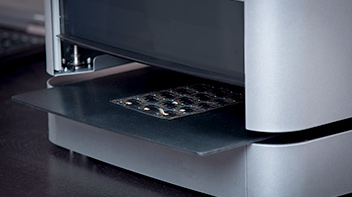XRF is highly sensitive to metallic elements, particularly elements ranging from Ti-U on the periodic table. For coating thickness analysis, XRF can be applied to any metallic coating, single or multi-layered, over any metallic or non-metallic substrate.
For alloy analysis, XRF can determine the % composition for each alloying element and identify the alloy grade number designation. For solutions analysis, metal ions in plating baths can be quantified for process control.

Key Features of the Bowman System
- Non-destructive testing with minimal sample preparation
- Fast analysis – data is available in seconds
- Inexpensive operation: can be run by novice operators without dedicated scientist
- Versatile technique can accommodate different types of matrix samples
- Small spot analysis for micro features on a large sample
- Simultaneous analysis of most metallic elements
- Widely accepted industrial verification testing method
Compare the different detector technologies used in x-ray fluorescence instruments
Gas Filled Prop Counter Detector
- High baseline noise
- Poor resolution
- Unstable with temp & humidity change
- Requires frequent re-calibrations
Silicon PIN Diode Detector
- Low noise level
- Great resolution
- Great detection limits
- Peltier cooled: very stable – no climate effects
Silicon Drift Detector (SDD)
- Lowest baseline noise
- Highest counts detection
- Highest resolution
- Best detection limits
- Greatest versatility for widest element range
- Peltier cooled: very stable – no climate effects
All Bowman XRF instruments use silicon drift detectors for highest resolution, lowest noise levels and greatest overall stability.
This ensures the most precise coating thickness measurement and elemental analysis possible.


 Made in the USA
Made in the USA